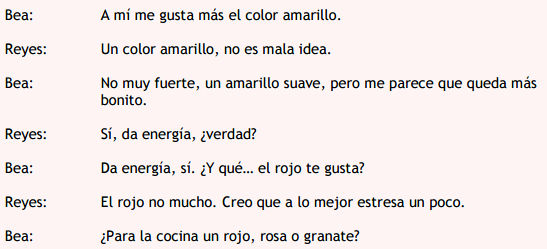
Rápido Español
Lesson 2: The Dialogue Deconstruction Method
Try this effective technique to rapidly improve your conversational ability Spanish
If you have ever purchased a typical Spanish book, or taken a Spanish course in college or high school, then you probably spent 90% of your time focused on vocabulary and grammar and less than 10% - if any - actually hearing and speaking Spanish out loud.
You probably even thought that this made sense - you have to learn lots of words before you start learning how to speak, right?
The truth is you need relatively few words to be able to get through a typical Spanish conversation. Based on an analysis of the frequency distribution of words in Spanish, a person with a vocabulary of only 1000 words would be able to recognize about 88% of the Spanish used in everyday conversation.
In fact, learning only the 600 most commonly used words would allow you to understand about 80-85% of the words in spoken Spanish - enough to get through most basic conversations.
The real problem for most beginner to intermediate Spanish learners is that there is a significant gap between their "paper" vocabulary - the number of words they can recognize on paper - and their ability to understand the same words in real-time spoken conversation.
To see what we mean, try the following exercise from (taken from our premium conversational Spanish course One Month Spanish).
The audio clip below contains a short dialogue between a man and the bellhop at his hotel. Most of the words used in the dialogue should be familiar to students who know a modest amount of Spanish vocabulary. Listen to the clip and see how well you can understand the discussion.
Note: Be sure to listen to the audio before reading the transcript that follows.
How well did you do? Did you miss anything?
Now try reading the transcript of the previous conversation:
Compare your results: Did you understand the material better through listening or reading?
If you answered "reading" then your issue is not lack of sufficient vocabulary, but rather inability to mentally process oral speech as quickly as the written word.
If you want to improve your ability to understand oral Spanish, the answer is not learning more vocabulary, but rather improving your ability to recognize and understand the Spanish that you already know.
Introducing the Dialogue Deconstruction Method:
The Dialogue Deconstruction Method is a skill-building technique designed to help you understand spoken Spanish as easily as if you were seeing the words printed on paper.
The gist of the method is to work through audio recordings of Spanish conversations by applying a step-by-step process to “decode” these conversations over a series of sequential steps.
To practice the Dialogue Deconstruction Method, you will need an audio clip of a short (1-3 minute) dialogue in Spanish, along with a Spanish transcript of the conversation and English translation.
Once you have the necessary materials, complete each of the following steps in order:
Step 1 – Start by simply listening to the whole dialogue once or twice all the way through. Try to understand as much as you can without stopping or pausing the audio. Don't worry if you do not understand much at first -- at this stage you are simply trying to get your brain "tuned in" to recognizing any words you might know.
Step 2 – Study the Spanish transcript until you understand the meaning of each sentence in written form. Be sure to note any new words or phrases that you don't already know. (I recommend adding them to a spaced repetition program like Anki or a flashcard app like Quizlet so you can review them later).
Once you are ready, cover up the English translation and test yourself by going through the Spanish dialogue one line at a time and trying to translate each sentence to English. You may need to repeat this step one or more times. Do not proceed to the next step until you are able to translate each phrase without looking at the English translation.

Test your understanding of the material by reviewing the Spanish transcript without the English translation.
Step 3 – This is the most crucial part. Now go back to the audio and play it again one sentence at a time. Pause the audio after each sentence and write down what you hear in Spanish.
Our goal in this step is to mentally "sync" what we hear in the audio to written transcript. Because these are the same phrases that you reviewed in the last step, you should already be “primed” to recognize these phrases when you hear them on the audio.
Try to transcribe the audio line by line in this fashion without referring to the written transcript.
Step 4 – Finally, re-listen to the full dialogue from start to finish. If you completed the previous steps, you should find that you are able to understand most, if not all, of the conversation fairly easily.
As you can see, the idea here is essentially to work backward to “deconstruct” the material in successive stages. Once you have studied the phrases in written form, you brain will be primed to mentally “sync” the audio to what you've already learned on paper.
Even if you could barely understand a word of the conversation in the beginning, you should find that you are able to understand most of it quite easily after completing these steps.
If you use this method regularly (I recommend at least 3 times per week), you should find that it quickly improves your ability to "tune in" to native Spanish speakers in everyday conversation. Regular practice with this technique will pay enormous dividends on your ability to understand even difficult, fast paced Spanish speakers.
Finding your audio:
When selecting audio to use with this technique, I recommend sticking with audio that meets the following criteria:
- The content of the audio should feature 1-on-1 dialogue between two or more people (rather than speeches or monologues).
- The length of the conversation should last no more than 1-3 minutes. The first few times you try this technique, I recommend starting with even shorter files - 30 secs to one minute.
- The dialogue should sound as authentic as possible in terms of speed and accent – if you have a choice between slow audio designed for beginners or one that features native speakers conversing in rapid-fire Spanish, choose the latter one. The idea is to train your ear to recognize how native speakers really talk so we want to focus on materials that are as authentic as possible.
- Finally, make sure that the audio you select includes a complete Spanish transcript of the dialogue along with an English translation.
TIP: You can find native Spanish audio on a number of free and paid websites. If you don't mind spending a little bit of time searching around, Audiria contains thousand of Spanish podcasts and audio files. Just be careful to stick to the criteria described above.
If you don't want to search for a bunch of audio files and transcripts on your own and simply want everything laid out for your, check out our complete conversational Spanish course One Month Spanish that contains all of the audio, transcripts, translations that you need to apply this method in one place.
COURSE SYLLABUS:
Lesson 1: Why traditional language learning methods don't work - and how to fix them.
Lesson 2: How to master Spanish conversation with the Dialogue Deconstruction Method
Lesson 3: How to improve grammar and retention with the Paragraph "Deep Dive"
Lesson 4: How to use the "Hollywood" technique to build fluency and confidence in speaking situations
Lesson 5: How to use the Kindle technique to build custom, context-based vocabulary lists
Lesson 6: How to put everything together into a complete learning system
Try it:
To help you get started with this method, I've created an Audio Lesson Pack loaded with native Spanish conversations ideal for applying the Dialogue Deconstruction Method.
You can download a free sample of the Audio Lesson Pack by click the button below. (be sure to scroll down the page to see the special bonus I've included for Rápido Español members).
What do you think about this technique? Leave a comment below.
Copyright © 2014 One Month Languages. Privacy Policy.
